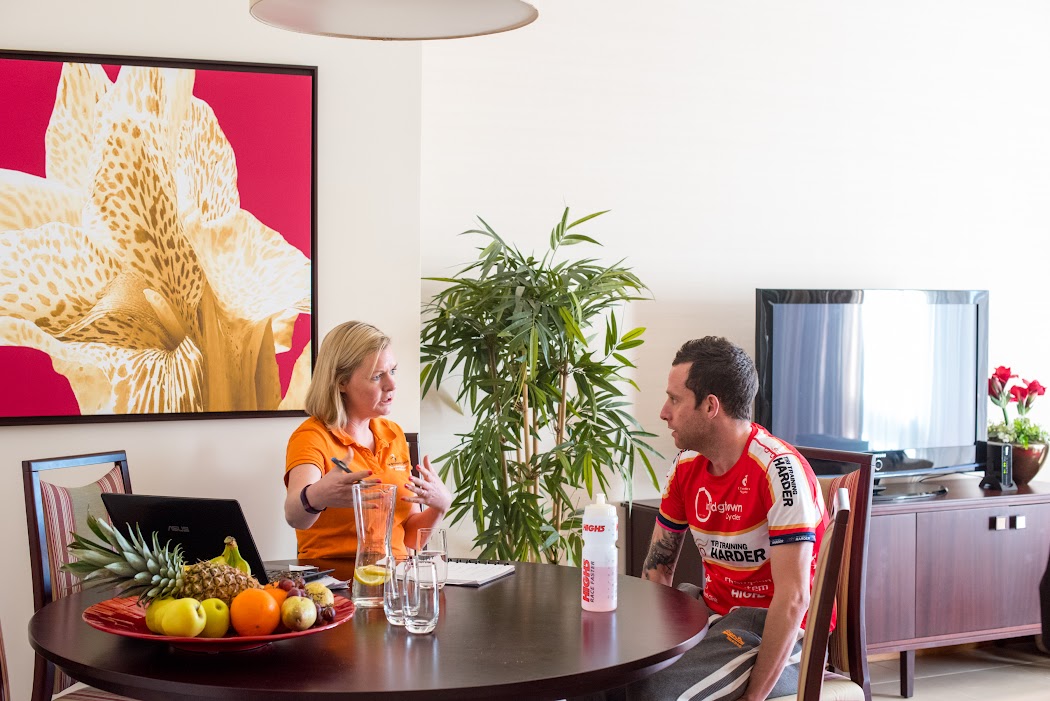In this blog Race Team athlete, Elaine Garvican, explains how keeping a food diary and consulting with The Bosworth Clinic's Nutritionist allowed her to adapt her diet. The changes Elaine has implemented have left her with more energy throughout the day which ultimately means she can train more effectively.
 |
| Elaine training in the Algarve, Portugal |
They say an army marches on its stomach and it’s certainly true that triathletes race on theirs. Age Groupers and Pros alike have suffered the impotent frustration of cramps, vomiting or bloating derailing a race. In that respect I'm very lucky, never having experienced the misery of mid-race GI distress or prolonged portaloo stops. But that's not to say that one key to unlocking my optimal race performance might not still be rooted in my nutritional choices.
Triathlon training requires many hours of hard work, periods of functional overreaching, and the crucial, often neglected phase of recovery, all of which need the right kind of feeding. Anyone who's ever trained for an Ironman will be aware of the almost insatiable hunger that can accompany some blocks, when it almost doesn't matter onto what your eyes first land, your singular focus is just to consume something and chewing only serves to delay that process. But what you reach for does matter, and as I'm learning, it's not just a matter of calories.
The Tri Training Harder Race Team are fortunate in that we don't have to figure this out on our own. We receive support from The Bosworth Clinic, where registered nutritionist Helen Money keeps a close eye on our diets. My teammates and I were recently asked to complete a food diary for Helen to look over, noting down not only what we ate or drank, and when, but also our training for that day. I've always considered my diet to be pretty good – I eat mostly things I've cooked myself, from fresh ingredients, including plenty of fruit and vegetables – and there was much that Helen has been happy with from the start. But I'd also been brought up to believe that snacks weren't something to be encouraged on a regular basis, with 3 good quality meals being sufficient – except of course for mid-session fuelling. For the average, (fairly sedentary!) adult, snacks may well not be particularly necessary, but add in 10-15 hours of training, alongside the muscular developmental demands of progressive strength and fitness, and the daily nutritional and calorific needs of the ironman-in-training start to look a little different.
Helen and Race Team athlete Jason Walkley discussing Jason's nutritional needs
at the Race Team IST in January 2016
One aspect Helen has helped me with recently is with regards to optimising my protein intake throughout the day. Although I knew that protein is vital for muscle development, I hadn't put as much thought as I perhaps ought to have done into the timing or the source of what I ate.
I'm of the opinion that breakfast is the best meal of the day, so a second breakfast following a hard morning swim is certainly no hardship for me, and that's a perfect time to get in another dairy-based-protein meal. Although I favour “real”, solid food where possible, there are times when the practicality and ease of compliance swing the balance towards a drink. A favourite of mine is a big glass of milk following a run, and here Helen’s suggestion was to boost this with whey protein and extra carbohydrate. I've no idea what whey protein tastes like straight, but luckily we are also sponsored by High5 so it's easy to put a couple of scoops of Summer Fruits High5 Protein Recovery into a bottle of milk and leave it in the fridge before going out for a hard session. That way, when I get back in, there's no requirement for me to think about what to eat or to prepare anything; my drink gives me my 38g of protein and 68g of carbohydrates and once I've drunk it, I can take my time to stretch and shower (and of course, upload my Garmin!). Plus, if I've raced a XC, or my session doesn't have me finishing at home for whatever reason, it's easy to pack a protein recovery bar with a banana.
High5 Protein Recovery is an excellent source of protein for when you
have finished a hard training session
To be honest, I didn't really expect to notice much of a difference after implementing these changes. I sort of figured that the extra amino acids would help me build more muscle, but thought this would all be happening on a cellular level far removed from my hunger centres. But I've been wrong – I now have fewer energy dips, because the fuel I shovel in is more appropriate for what my body needs in the immediate aftermath of a tough session. As the training load goes up throughout the year, and full, effective recovery becomes ever more crucial, this will only become more valuable.

